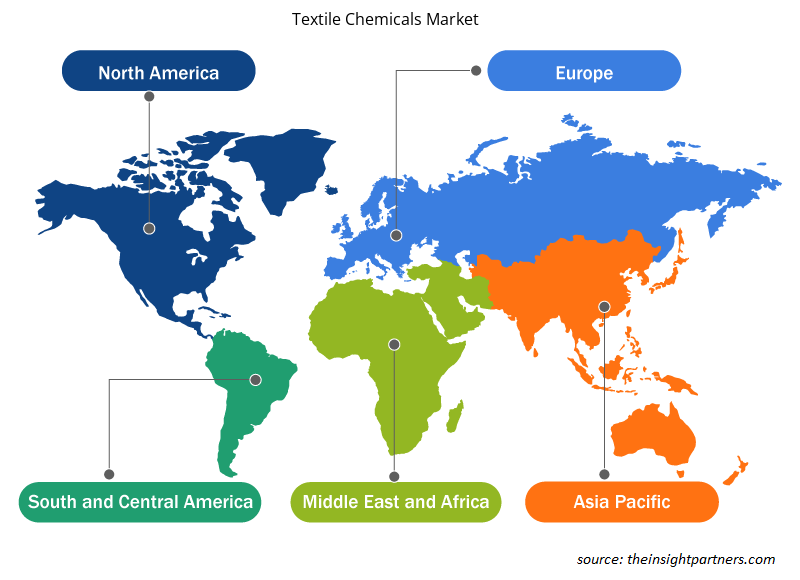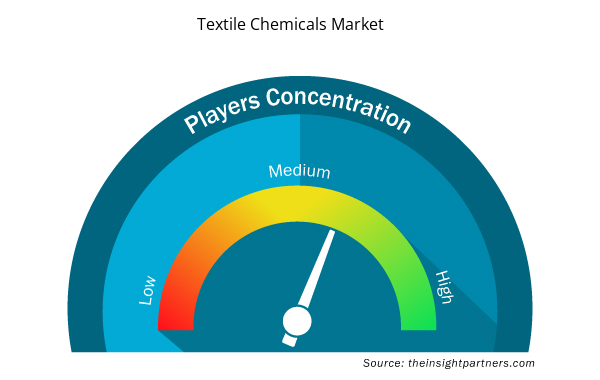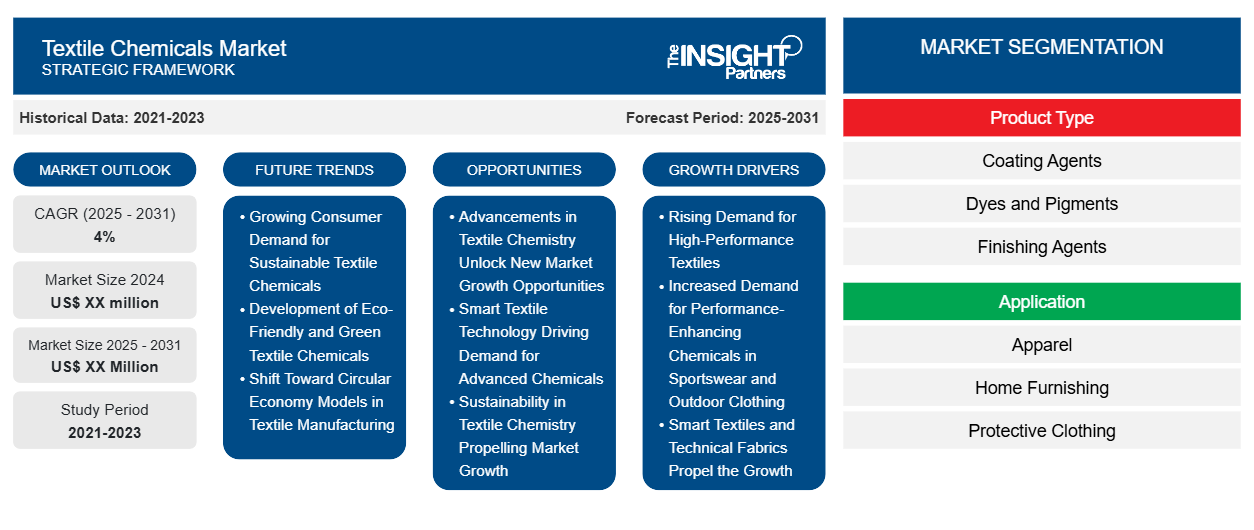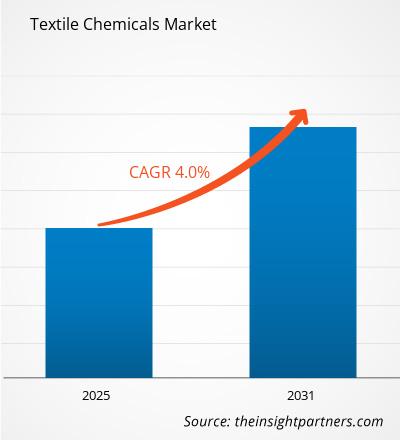预计纺织化学品市场在 2024 年至 2031 年期间的复合年增长率为 4%,市场规模将从 2024 年的 XX 百万美元扩大到 2031 年的 XX 百万美元。
报告根据产品类型(涂层剂、染料和颜料、整理剂、表面活性剂、退浆剂等)进行分析。报告按应用(服装、家居、防护服等)进行细分。全球分析进一步细分为区域和主要国家。范围涵盖所有关键细分市场的全球、区域和国家层面的市场规模和预测。报告以美元为单位提供上述分析和细分市场的价值。报告提供了主要市场参与者的市场状况的关键统计数据,并提供了市场趋势和机会。
报告目的
The Insight Partners 发布的《纺织化学品市场》报告旨在描述当前形势和未来增长、主要驱动因素、挑战和机遇。这将为各种商业利益相关者提供见解,例如:
- 技术提供商/制造商:了解不断变化的市场动态并了解潜在的增长机会,从而能够做出明智的战略决策。
- 投资者:对市场增长率、市场财务预测以及整个价值链中存在的机会进行全面的趋势分析。
- 监管机构:监管市场政策和警察活动,旨在最大限度地减少滥用行为,维护投资者的信任和信心,维护市场的完整性和稳定性。
纺织化学品市场细分
产品类型
- 涂层剂
- 染料和颜料
- 整理剂
- 表面活性剂
- 退浆剂
应用
- 服饰
- 家居装饰
- 防护服
定制此报告以满足您的需求
您可以免费定制任何报告,包括本报告的部分内容、国家级分析、Excel 数据包,以及为初创企业和大学提供优惠和折扣
- 获取此报告的关键市场趋势。这个免费样品将包括数据分析,从市场趋势到估计和预测。
纺织化学品市场增长动力
- 高性能纺织品需求不断增长:高性能纺织品需求不断增长是推动纺织化学品市场增长的主要因素之一。各种行业都需要对高性能纺织品进行专门的化学处理,以提高耐用性、吸湿排汗性、阻燃性等。因此,对先进纺织化学品的需求巨大。
- Increased Demand for Performance-Enhancing Chemicals in Sportswear and Outdoor Clothing: As textile industries look forward to more functional products, the demand for chemicals that deliver improved performance increases. For example, chemicals that enhance fabric strength, elasticity, and resistance to UV rays find major applications in sportswear and outdoor clothing. This is one of the factors behind the growth of the textile chemicals market since manufacturers are investing in novel chemical solutions.
- Smart Textiles and Technical Fabrics Propel the Growth: Smart textiles and technical fabrics that contain sensors or conductive materials are an emerging industry. Such textiles require chemicals for the complex manufacturing processes they undergo without compromising the functionality of the embedded electronics. With a growing application base for smart textiles, their textile chemicals market is fast on the growth track due to special products.
Textile Chemicals Market Future Trends
- Growing Consumer Demand for Sustainable Textile Chemicals: Rising consumer preference for sustainable products is one of the most significant future trends driving growth in the market for textile chemicals. Consumers, being increasingly eco-conscious, tend to demand more environmental-friendly textiles. This trend has been compelling manufacturers to adopt sustainable textile chemicals that minimize environmental impact while maintaining standards of high-quality product delivery.
- Development of Eco-Friendly and Green Textile Chemicals: The development of green chemicals, like biodegradable dyes, water-based finishes, and eco-friendly treatments in fabrics. These have significantly beneficial impacts on emissions, consumption of water and levels of toxic waste produced during manufacture, meeting both regulatory as well as consumer expectations. This gives impetus to market growth as manufacturers shift to greener alternatives.
- Shift Toward Circular Economy Models in Textile Manufacturing: The bigger pressure on the fashion and textile industries is to operate through models of circular economy whereby products are recycled instead of being thrown away, and chemical textiles that will neither harm the fabric recyclability process are considered highly. The textile chemicals market is already evolving to offer solutions that work with sustainability at their core.
Textile Chemicals Market Opportunities
- Advancements in Textile Chemistry Unlock New Market Growth Opportunities: The market of textile chemicals is wide open for enormous growth opportunities, given the advances in textile chemistry. New formulations and processes, for example, would enable the production of high-performance and more effective products; in addition, there is a requirement for specialized chemicals to respond to the ever-increasing need for durability features, moisture management, or protection against UV light in textiles.
- Smart Textile Technology Driving Demand for Advanced Chemicals: Further, smart technology infusion into textiles is spurring demand for advanced chemicals in textiles smarts. That is, smart textiles designed to incorporate conductive materials or sensors will need chemicals to keep them working well. Since the application is growing into healthcare, electronics, and sports apparel, the growth of textile chemicals could be improved.
- Sustainability in Textile Chemistry Propelling Market Growth: Advances in sustainable textile chemistry also play a prominent role in the market growth. Eco-friendly and biodegradable chemicals, such as water-based dyes and non-toxic finishes, are being developed to improve the sector's shift toward greener production processes. Thus, environmentally friendly textile chemicals are gaining momentum. Consumers are increasingly seeking eco-friendly products, while environmental legislation is becoming stricter.
Textile Chemicals Market Regional Insights
The regional trends and factors influencing the Textile Chemicals Market throughout the forecast period have been thoroughly explained by the analysts at Insight Partners. This section also discusses Textile Chemicals Market segments and geography across North America, Europe, Asia Pacific, Middle East and Africa, and South and Central America.

- Get the Regional Specific Data for Textile Chemicals Market
Textile Chemicals Market Report Scope
| Report Attribute | Details |
|---|---|
| Market size in 2024 | US$ XX million |
| Market Size by 2031 | US$ XX Million |
| Global CAGR (2024 - 2031) | 4% |
| Historical Data | 2021-2023 |
| Forecast period | 2025-2031 |
| Segments Covered | By Product Type
|
| Regions and Countries Covered | North America
|
| Market leaders and key company profiles |
|
Textile Chemicals Market Players Density: Understanding Its Impact on Business Dynamics
The Textile Chemicals Market market is growing rapidly, driven by increasing end-user demand due to factors such as evolving consumer preferences, technological advancements, and greater awareness of the product's benefits. As demand rises, businesses are expanding their offerings, innovating to meet consumer needs, and capitalizing on emerging trends, which further fuels market growth.
市场参与者密度是指在特定市场或行业内运营的企业或公司的分布情况。它表明相对于给定市场空间的规模或总市场价值,有多少竞争对手(市场参与者)存在于该市场空间中。
在纺织化学品市场运营的主要公司有:
- 阿克苏诺贝尔公司
- 昂高
- 博泽托集团
- 陶氏杜邦
- 德司达新加坡私人有限公司
免责声明:上面列出的公司没有按照任何特定顺序排列。

- 了解纺织化学品市场主要参与者概况
主要卖点
- 全面覆盖:报告全面涵盖了纺织化学品市场的产品、服务、类型和最终用户的分析,提供了整体概况。
- 专家分析:报告基于对行业专家和分析师的深入了解而编写。
- 最新信息:该报告涵盖了最新信息和数据趋势,确保了其与业务的相关性。
- 定制选项:此报告可以定制以满足特定客户要求并恰当地适应业务策略。
因此,纺织化学品市场研究报告有助于引领解读和了解行业情景和增长前景。尽管可能存在一些合理的担忧,但本报告的总体优势往往大于劣势。
- 历史分析(2 年)、基准年、预测(7 年)及复合年增长率
- PEST 和 SWOT 分析
- 市场规模价值/数量 - 全球、区域、国家
- 行业和竞争格局
- Excel 数据集


- Rare Neurological Disease Treatment Market
- Aircraft MRO Market
- Customer Care BPO Market
- Legal Case Management Software Market
- Flexible Garden Hoses Market
- Enteral Nutrition Market
- Sleep Apnea Diagnostics Market
- Asset Integrity Management Market
- Unit Heater Market
- Nuclear Decommissioning Services Market

Report Coverage
Revenue forecast, Company Analysis, Industry landscape, Growth factors, and Trends

Segment Covered
This text is related
to segments covered.

Regional Scope
North America, Europe, Asia Pacific, Middle East & Africa, South & Central America

Country Scope
This text is related
to country scope.
常见问题
Rising consumer preference for sustainable products is expected to be the key market trends.
Based on geography, Asia Pacific held the largest share of the textile chemicals market, as the countries like China, India, and Bangladesh are major manufacturing hubs, producing a vast volume of textiles and garments, which creates a high demand for textile chemicals in processes like dyeing, finishing, and printing.
Based on product type, the coating agents segment is expected to witness the fastest growth during the forecast period
The growing demand for high-performance textiles is driving the market growth.
BASF SE; Archroma; Huntsman Corporation; DyStar Group; Tanatex Chemicals; Kyung-In Synthetic Corporation (KISCO); NICCA Chemicals Co. Ltd; Indofil Industries Limited; Rudolf GmbH; and Sumitomo Chemical Co. Ltd are some of textile chemicals market
The Textile Chemicals Market is estimated to witness a CAGR of 4% from 2023 to 2031
Trends and growth analysis reports related to Chemicals and Materials : READ MORE..
The List of Companies
- Akzo Nobel NV
- Archroma
- Bozzetto Group
- DowDuPont
- DyStar Singapore Pte Ltd
- Evonik Industries AG
- Huntsman International LLC
- Rudolf GmbH
- Tanatex Chemicals B.V.
- Wacker Chemie AG
- Univar Inc
- Kolor Jet Chemical Pvt. Ltd
- Jay Chemical Industries Ltd.
- Chungyo Chem
- Transfar Group Co., Ltd.
- Omya
- The Lubrizol Corporation
- Sumitomo Chemicals Co. Ltd
- Buckman
- Sarex
The Insight Partners performs research in 4 major stages: Data Collection & Secondary Research, Primary Research, Data Analysis and Data Triangulation & Final Review.
- Data Collection and Secondary Research:
As a market research and consulting firm operating from a decade, we have published and advised several client across the globe. First step for any study will start with an assessment of currently available data and insights from existing reports. Further, historical and current market information is collected from Investor Presentations, Annual Reports, SEC Filings, etc., and other information related to company’s performance and market positioning are gathered from Paid Databases (Factiva, Hoovers, and Reuters) and various other publications available in public domain.
Several associations trade associates, technical forums, institutes, societies and organization are accessed to gain technical as well as market related insights through their publications such as research papers, blogs and press releases related to the studies are referred to get cues about the market. Further, white papers, journals, magazines, and other news articles published in last 3 years are scrutinized and analyzed to understand the current market trends.
- Primary Research:
The primarily interview analysis comprise of data obtained from industry participants interview and answers to survey questions gathered by in-house primary team.
For primary research, interviews are conducted with industry experts/CEOs/Marketing Managers/VPs/Subject Matter Experts from both demand and supply side to get a 360-degree view of the market. The primary team conducts several interviews based on the complexity of the markets to understand the various market trends and dynamics which makes research more credible and precise.
A typical research interview fulfils the following functions:
- Provides first-hand information on the market size, market trends, growth trends, competitive landscape, and outlook
- Validates and strengthens in-house secondary research findings
- Develops the analysis team’s expertise and market understanding
Primary research involves email interactions and telephone interviews for each market, category, segment, and sub-segment across geographies. The participants who typically take part in such a process include, but are not limited to:
- Industry participants: VPs, business development managers, market intelligence managers and national sales managers
- Outside experts: Valuation experts, research analysts and key opinion leaders specializing in the electronics and semiconductor industry.
Below is the breakup of our primary respondents by company, designation, and region:

Once we receive the confirmation from primary research sources or primary respondents, we finalize the base year market estimation and forecast the data as per the macroeconomic and microeconomic factors assessed during data collection.
- Data Analysis:
Once data is validated through both secondary as well as primary respondents, we finalize the market estimations by hypothesis formulation and factor analysis at regional and country level.
- Macro-Economic Factor Analysis:
We analyse macroeconomic indicators such the gross domestic product (GDP), increase in the demand for goods and services across industries, technological advancement, regional economic growth, governmental policies, the influence of COVID-19, PEST analysis, and other aspects. This analysis aids in setting benchmarks for various nations/regions and approximating market splits. Additionally, the general trend of the aforementioned components aid in determining the market's development possibilities.
- Country Level Data:
Various factors that are especially aligned to the country are taken into account to determine the market size for a certain area and country, including the presence of vendors, such as headquarters and offices, the country's GDP, demand patterns, and industry growth. To comprehend the market dynamics for the nation, a number of growth variables, inhibitors, application areas, and current market trends are researched. The aforementioned elements aid in determining the country's overall market's growth potential.
- Company Profile:
The “Table of Contents” is formulated by listing and analyzing more than 25 - 30 companies operating in the market ecosystem across geographies. However, we profile only 10 companies as a standard practice in our syndicate reports. These 10 companies comprise leading, emerging, and regional players. Nonetheless, our analysis is not restricted to the 10 listed companies, we also analyze other companies present in the market to develop a holistic view and understand the prevailing trends. The “Company Profiles” section in the report covers key facts, business description, products & services, financial information, SWOT analysis, and key developments. The financial information presented is extracted from the annual reports and official documents of the publicly listed companies. Upon collecting the information for the sections of respective companies, we verify them via various primary sources and then compile the data in respective company profiles. The company level information helps us in deriving the base number as well as in forecasting the market size.
- Developing Base Number:
Aggregation of sales statistics (2020-2022) and macro-economic factor, and other secondary and primary research insights are utilized to arrive at base number and related market shares for 2022. The data gaps are identified in this step and relevant market data is analyzed, collected from paid primary interviews or databases. On finalizing the base year market size, forecasts are developed on the basis of macro-economic, industry and market growth factors and company level analysis.
- Data Triangulation and Final Review:
The market findings and base year market size calculations are validated from supply as well as demand side. Demand side validations are based on macro-economic factor analysis and benchmarks for respective regions and countries. In case of supply side validations, revenues of major companies are estimated (in case not available) based on industry benchmark, approximate number of employees, product portfolio, and primary interviews revenues are gathered. Further revenue from target product/service segment is assessed to avoid overshooting of market statistics. In case of heavy deviations between supply and demand side values, all thes steps are repeated to achieve synchronization.
We follow an iterative model, wherein we share our research findings with Subject Matter Experts (SME’s) and Key Opinion Leaders (KOLs) until consensus view of the market is not formulated – this model negates any drastic deviation in the opinions of experts. Only validated and universally acceptable research findings are quoted in our reports.
We have important check points that we use to validate our research findings – which we call – data triangulation, where we validate the information, we generate from secondary sources with primary interviews and then we re-validate with our internal data bases and Subject matter experts. This comprehensive model enables us to deliver high quality, reliable data in shortest possible time.


 获取此报告的免费样本
获取此报告的免费样本